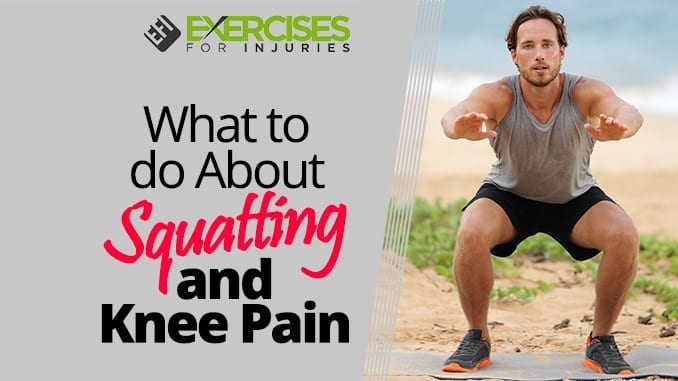Squatting may be difficult for people with knee pain or sitting most of the day due to their job or other factors. Still, there are ways to safely introduce squatting into your workout routine and relieve knee pain simultaneously.
While at the gym, I got some questions about knee pain and squatting.
I gave my typical answers but wanted to check my answers when I got home by looking at the research.
I dug into the research, and here I found a few things great to do again as it has been some time since I have done a post like this.)
How Deep to Squat with a Painful Knee?
What They Looked At
They looked at the knee forces in the tibiofemoral joint (the thigh bone moving on the shin bone) and the patellofemoral joint (knee cap on thigh bone) related to squatting.
What They Found
- A parallel squat (thigh parallel to the floor) is recommended over a deep squat as the injury potential to the menisci, cruciate, and collateral ligaments increases with a deep squat.
- Quadriceps, hamstring, and gastrocnemius activity increased with knee flexion during the squat.
- They recommended that knee movements be rehabilitated from 0 to 50 degrees of knee flexion, which they classified as a functional knee range.
Recommendation
The squat is safe for ligament injuries, but when moving into a deep squat, there is a great risk of injury to the inside of the joint and the ligaments. When the knee is injured, and in a rehabilitation situation, this must be considered. The cost/benefit needs to be considered for a healthy knee.
What Happens to the Knee Joints when Squatting with Weight?
What They Looked At
This research looked at healthy adults that performed a single repetition bilateral squat with knee flexion reaching 90 degrees. They looked at the patellofemoral joint forces without external load and with external load (35% of the subject’s body weight.)
Fifteen healthy adults performed single-repetition squats to 90 degrees of knee flexion without an external load and with an external load.
What They Found
- Patellofemoral joint forces increased with knee flexion (increase in squat depth).
- The addition of external load increased patellofemoral reaction forces.
Recommendation
If you have patellofemoral or anterior knee pain, you can decrease the stress on the joints by decreasing the squat depth and reducing or eliminating load.
What Effect do Leg Exercises Have on the ACL?
This was a fascinating article with so much information.
What They Looked At
They reviewed the research to see what it had to say about exercises and the forces they put on the ACL.
What They Found
- There was a greater stress on the ACL during non-weight-bearing exercises (seated knee extension without resistance) versus weight-bearing exercises (squatting).
- ACL is loaded more during 10 to 50 degrees of knee flexion than 50 to 100 degrees.
- Squatting with knees past the toes and heels off the ground increases the load on the ACL.
Recommendations
This is a great article. If you work with people with ACL injuries or you have one, I would suggest getting your hands on it. It highlights ACL stresses for leg extension, barbell squat, leg press, wall squat, single-leg squat, lunging, walking, and jumping.
There is a lot of great research on squatting and its effect on knee pain.
Rick Kaselj, MS
Escamilla RF. (2001). Knee biomechanics of the dynamic squat exercise. Med Sci Sports Exerc. 2001 Jan;33(1):127-41.
Wallace DA, Salem GJ, Salinas R, Powers CM. (2002). Patellofemoral joint kinetics while squatting with and without an external load. J Orthop Sports Phys Ther. 2002 Apr;32(4):141-8.
Escamilla RF, Macleod TD, Wilk KE, Paulos L, Andrews JR. (2012). Anterior cruciate ligament strain and tensile forces for weight-bearing and non-weight-bearing exercises: a guide to exercise selection. J Orthop Sports Phys Ther. 2012 Mar;42(3):208-20. DOI: 10.2519/jospt.2012.3768. Epub 2012 Feb 29.

